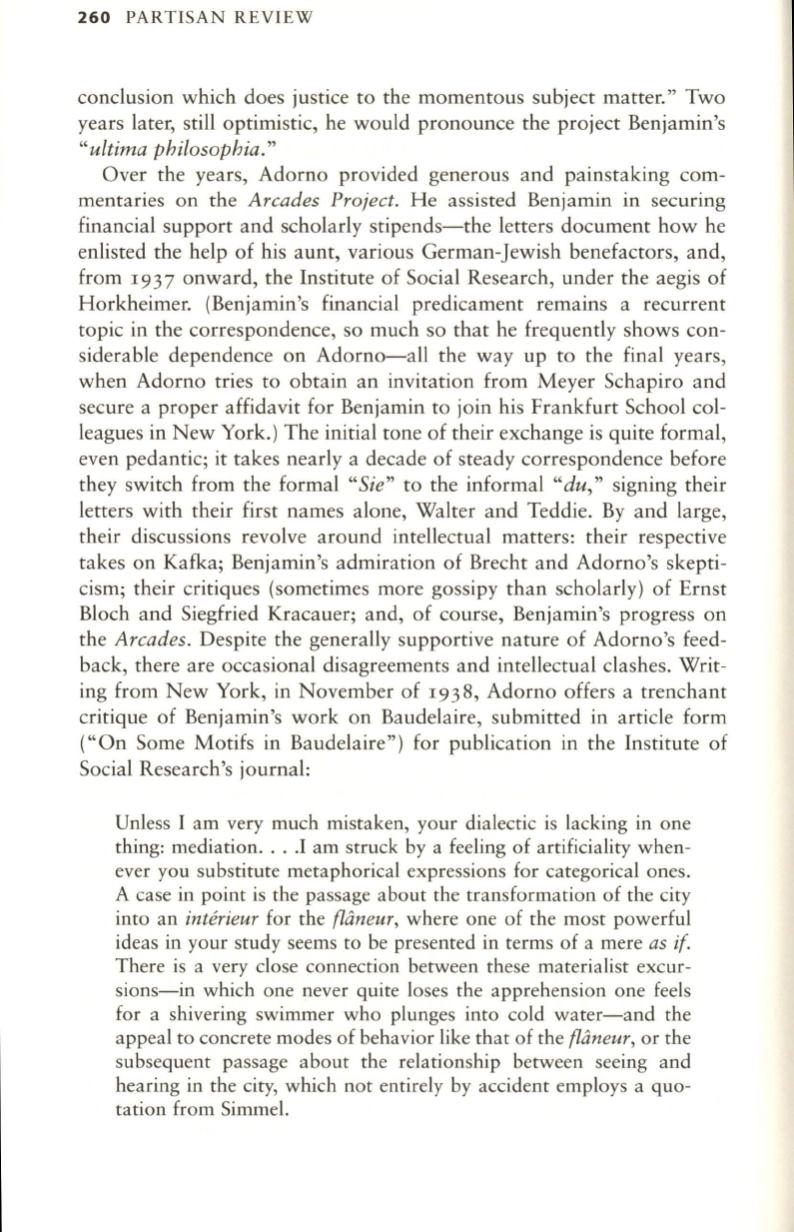
260
PARTISAN REVIEW
conclusion which does justice to the momentous subject matter." Two
years later, still optimistic, he would pronounce the project Benjamin's
"ultima philosophia."
Over the years, Adorno provided generous and painstaking com–
mentaries on the
Arcades Project.
He assisted Benjamin in securing
financial support and scholarly stipends-the letters document how he
enlisted the help of his aunt, various German-Jewish benefactors, and,
from
1937
onward, the Institute of Social Research, under the aegis of
Horkheimer. (Benjamin's financial predicament remains a recurrent
topic in the correspondence, so much so that he frequently shows con–
siderable dependence on Adorno-all the way up to the final years,
when Adorno tries to obtain an invitation from Meyer Schapiro and
secure a proper affidavit for Benjamin to join his Frankfurt School col–
leagues in New York.) The initial tone of their exchange is quite formal,
even pedantic; it takes nearly a decade of steady correspondence before
they switch from the formal
"Sie"
to the informal
"du,"
signing their
letters with their first names alone, Walter and Teddie. By and large,
their discussions revolve around intellectual matters: their respective
takes on Kafka; Benjamin's admiration of Brecht and Adorno's skepti–
cism; their critiques (sometimes more gossipy than scholarly) of Ernst
Bloch and Siegfried Kracauer; and, of course, Benjamin's progress on
the
Arcades.
Despite the generally supportive nature of Adorno's feed–
back, there are occasional disagreements and intellectual clashes. Writ–
ing from New York, in November of
1938,
Adorno offers a trenchant
critique of Benjamin's work on Baudelaire, submitted in article form
("On Some Motifs in Baudelaire") for publication in the Institute of
Social Research's journal:
Unless I am very much mistaken, your dialectic is lacking in one
thing: mediation...
.I
am struck by a feeling of artificiality when–
ever you substitute metaphorical expressions for categorical ones.
A case in point is the passage about the transformation of the city
into an
interieur
for the
flimeur,
where one of the most powerful
ideas in your study seems to be presented in terms of a mere
as if.
There is a very close connection between these materialist excur–
sions-in which one never quite loses the apprehension one feels
for a shivering swimmer who plunges into cold water-and the
appeal to concrete modes of behavior like that of the
flimeur,
or the
subsequent passage about the relationship between seeing and
hearing in the city, which not entirely by accident employs a quo–
tation from Simmel.


